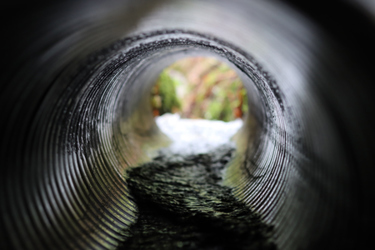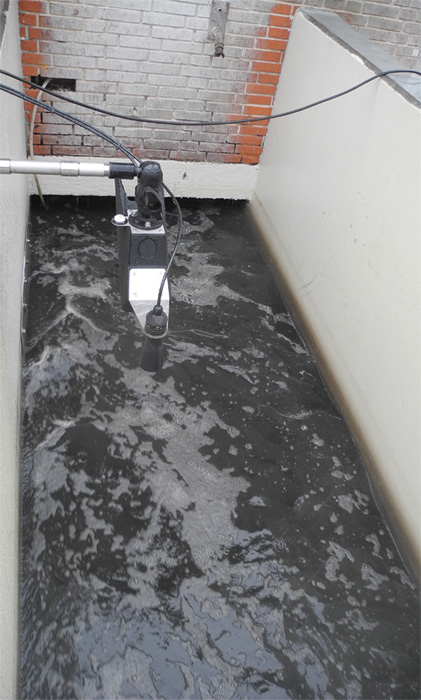How To Strengthen Your Flow Monitoring Strategy … Before The Next Overflow
By Vincent Favre

Strategic flow monitoring helps wastewater utilities curb overflows, cut costs, and safeguard public health by turning accurate data into proactive action.
Municipal wastewater systems are under siege from aging infrastructure, intense wet weather events, and increasingly strict regulatory enforcement. The result? A growing risk of sanitary sewer overflows (SSOs) and combined sewer overflows (CSOs) that lead to hefty fines, environmental damage, and public health hazards.
A robust, strategically deployed flow monitoring program is one of the best defenses against overflows. The right approach helps utilities comply with regulations while building operational resilience, well before the next big storm turns small vulnerabilities into full-blown crises.
Flow Meters: Not Just An Equipment Purchase
Flow monitoring is the backbone of informed decision-making for wastewater operations, especially for overflow prevention. Whether it’s part of an inflow and infiltration (I&I) reduction program, tracking wet weather surges, or optimizing system performance, accurate flow data equips operators to act quickly and strategically.
I&I alone can account for as much as half of all water treated in older systems with cracked pipes or leaky connections. During rain events, that figure can spike sharply, pushing pump stations and treatment plants to their limits and creating operational strain on top of potential environmental violations. In recent years, several U.S. municipalities have faced six-figure penalties for SSOs that spilled untreated wastewater into waterways.
Rather than looking at flow meters as just another equipment purchase, more utilities are taking a circumspect, operationally strategic approach. This prevents common pitfalls like sensors that are mismatched to their environments, data that requires proprietary platforms or is hard to interpret, or flow metering systems that are abandoned after a few years because maintenance costs and demands were underestimated. Investing in a robust, adaptable, and cost-conscious flow monitoring program isn’t just prudent — it’s essential.
To get the most from overflow prevention efforts, wastewater treatment operators should adopt a three-prong approach: Align flow meters with real-world conditions, plan for the full lifecycle of equipment, and leverage data into actionable decisions.
PRONG ONE: Match Sensor Technology To Real-World Challenges
No single type of flow meter can handle every scenario. Municipal and industrial sites often require a mix of sensor types to capture reliable data across a range of conditions. Fully understanding the situational, environmental, and existing infrastructure conditions is key to selecting the right sensor for the job. Variables that can make or break a deployment include pipe or channel size and shape, flow depth and variability, velocity range, turbulence, solids and debris content, chemical composition, access constraints, and safety factors.
By mapping these conditions first, utilities can narrow sensor options to those best suited for long-term performance. Two basic kinds of flow meters serve the majority of wastewater flow monitoring needs: submersible area-velocity flow meters and noncontact radar flow meters. More often, facilities are combining the strengths of both sensors in developing a more resilient system.
Submersible Area-Velocity Flow Meters: Proven Technology for Predictable, Easy Access Conditions
Submersible flow meters, typically mounted in the invert (bottom) of a pipe, measure velocity using ultrasonic Doppler technology and depth with a pressure level sensor. They are widely used in I&I studies because they’re costeffective, proven in the field, and easy to deploy in large numbers.
However, pressure sensors are often the first component to wear out, usually after two to three years of service. Traditionally, that requires replacing the entire device. Newer models have replaceable pressure level sensors, which significantly reduce lifecycle costs and maintenance burden by allowing operators to swap out only the worn component.
Best real-world fit: I&I studies, shallow-to-moderate flow depths, and locations where submersion is feasible and safe.

Non-Contact Radar Flow Meters: Advanced Sensors for Hazardous or Difficult Conditions
For large-diameter interceptors or channels with hazardous access conditions, non-contact sensors are a safer and often more reliable option. Mounted above the water, they measure surface velocity (via radar) and depth (via ultrasonic or radar level sensing), then calculate flow internally.
Because installation and servicing can be done from outside the flow stream, these sensors minimize confined space entry risks and downtime. They also excel in highly turbulent or debris-laden conditions where a submersible device might become buried or damaged.
Some non-contact flow meters are designed for industrial sludges, such as those from mining operations, which can be highly corrosive. In these conditions, sensors must be fully protected against chemical attack — often with specialized coatings like polyurethane — to avoid rapid deterioration.
Best fit: Large urban sewer mains, high-velocity storm flows, caustic or abrasive industrial effluents, and locations with hazardous access.
Dual-Sensor Installations: For Highly Variable Conditions and Maximum Risk Reduction
Some sites experience extreme seasonal variation. For example, a discharge pipe may run partially full most of the year but become surcharged for weeks during spring snowmelt or rainy season. In these cases, utilities sometimes install both non-contact and submersible meters, switching between them as conditions dictate.
Best fit: Pipes with seasonal full-flow events and systems with significant depth variation.
PRONG TWO: Plan For The Full Lifecycle Of Flow Monitoring Equipment
When it comes to flow monitoring, the “total cost” isn’t the purchase order; it’s the entire lifecycle of owning and operating the equipment. Many utilities have learned the hard way that a low upfront price can balloon into high operational costs if maintenance is frequent, parts are proprietary, or integration is limited. While utilities sometimes treat flow monitoring as a single capital purchase, achieving cost control requires accounting for both purchase and operating costs and depends on actively managing the flow metering program.
Include the cost of repairs: A meter that looks like a bargain at purchase can become a budget sink if it requires constant cleaning, frequent recalibration, or expensive proprietary parts. As previously mentioned, for example, newly available devices with replaceable pressure sensors allow for a quick, low-cost fix without scrapping the rest of the meter.
Consider maintenance accessibility: Meters installed in locations that require confined space entry can rack up labor costs quickly. Non-contact sensors mounted above the flow can often be installed and serviced without special permits or large crews.
Choose interoperability: Beware of vendors who sell flow meters that work only with their software, which will tie up more of a capital budget and reduce future flexibility. Opt instead for flow meters that are built on an open communication protocol that will integrate with existing SCADA, GIS, or asset management systems, regardless of the manufacturer. This allows a utility to upgrade sensors without replacing the entire network, saving substantial capital and personnel resources.
Compare features beyond baseline functionality: Devices that compute flow internally and output ready-to-use data simplify deployment and reduce the need for external processors. If your flows are challenging or subject to harsh conditions, consider devices with chemical-resistant materials and debris-tolerant designs. And if your system needs sensors that can adapt to sudden surges and high turbulence without losing accuracy, look for devices with rapid response capability.
Revisit site conditions periodically: Wastewater systems change over time through rehabilitation projects, new connections, or upstream development. A site that was hydraulically “perfect” for a meter five years ago might now surcharge after every heavy rain. Lifecycle planning means regularly reassessing whether each meter is still in the best possible location and configuration.
Beware of “single number” decision-making: A sensor claiming “±2% accuracy” under controlled conditions may not perform the same way when faced with real-life conditions, siltation, turbulence, or intermittent surcharge. Always ask vendors for independent test data in conditions similar to your own. Better yet, run your own comparison under live flow.
PRONG THREE: Leverage Flow Data To Make Better Decisions
The value of a flow monitoring program is measured not just in the collected data but in the operational decisions that data enable. When data are timely, accurate, and integrated into planning and response workflows, they become a strategic asset.
Data from advanced flow meters can trigger automated responses, such as diverting excess flow to storage basins when depth or velocity thresholds are exceeded. For combined sewer systems, these alerts can make the difference between a managed storm event and an unplanned overflow. The accuracy and speed of the sensors in detecting rapid depth and velocity changes are critical in rapid response situations.
For proactive overflow risk reduction measures, accurate and localized flow data from multiple points allow utilities to pinpoint I&I sources, rather than launching broad, costly repair campaigns. That precision reduces unnecessary excavation and focuses budget where it will have the most impact. For optimal long-term overflow mitigation planning, multiyear flow data sets can reveal chronic capacity issues, justify expansion projects, and help time upgrades to align with actual system demand, rather than assumptions.
In regions at risk of flash flooding, utilities can use flow monitoring data from stormwater channels and drainage ditches. When rainfall has the potential to overwhelm a system, these flow meters can feed hydraulic models that predict flood onset, giving emergency managers more lead time to deploy resources or issue warnings.
Flow data should influence operational and capital decisions — decisions that should then be evaluated for effectiveness using subsequent flow data. If a rehabilitation project doesn’t reduce I&I as expected, you’ll see it in the numbers, allowing for course correction.
The Bottom Line: Building Resilience Against The Next Overflow
A strong, resilient flow monitoring program is built on more than just hardware. It’s the product of an honest and holistic assessment of site realities, a commitment to long-term lifecycle planning, and the discipline to transform data into defensible, actionable decisions.
A resilient program will:
- Assess Vulnerabilities: Identify high-risk overflow points, difficult access areas, and seasonal flow extremes.
- Deploy Fit-for-Purpose Sensors: Match meter type to hydraulic and environmental conditions.
- Integrate with Decision Systems: Ensure data flow seamlessly to SCADA or other platforms that inform operational actions.
- Plan for Maintenance: Keep spare parts (like pressure sensors, for devices with replaceable sensors) on hand and schedule proactive replacements.
- Use Data Beyond Compliance: Leverage flow data for capital planning, storm response, and even flood prediction.
Overflow prevention is no longer just a regulatory requirement; it’s a core responsibility for protecting public health, the environment, and municipal budgets. By embracing modern flow meter technology, optimizing deployments for site-specific conditions, and building an integrated data strategy, wastewater utilities can shift from reactive crisis management to proactive system control.
When the next heavy rain hits — and it will — utilities with a well-matched mix of sensors, a plan for keeping them in top condition, and a strategy for acting on the data they provide will be the best insurance against overflows, fines, and public trust erosion.
About The Author
 Vincent Favre, North American Sales Manager at FLOW-TRONIC S.A., is an experienced director with a demonstrated history of working in the environmental services industry. Skilled in water conservation, flow monitoring instrumentation, managing distribution channels, and OEM partnership, Favre has been involved in the water and wastewater industry since 1998.
Vincent Favre, North American Sales Manager at FLOW-TRONIC S.A., is an experienced director with a demonstrated history of working in the environmental services industry. Skilled in water conservation, flow monitoring instrumentation, managing distribution channels, and OEM partnership, Favre has been involved in the water and wastewater industry since 1998.
